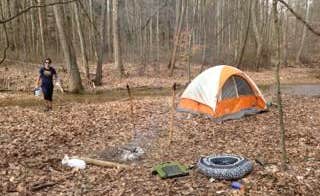Dispersed camping is available in the Hoosier National Forest near Elizabeth, Indiana, with elevations ranging from 350 to 900 feet throughout the forest. The terrain features a mix of hardwood forests, limestone formations, and small watersheds. Most free camping opportunities require either backpacking equipment or vehicles capable of navigating unmaintained forest roads that can become challenging in wet conditions.
What to do
Explore local trails: Jackson Trailhead offers access to several hiking paths with varying difficulty levels. One visitor noted there are "campsites along the trail just have to find them" after navigating "a decrepit gravel road" to reach the parking area.
Wildlife observation: The forested areas support diverse wildlife populations. At Mitchell Creek Road Dispersed, campers frequently encounter wildlife. One reviewer recommended to "lookout for turtles on the road, we spotted and removed 4 of them" while camping in the area.
Creek exploration: During drier months, creek beds provide interesting exploration opportunities. A camper at Mitchell Creek Road Dispersed mentioned "rock outcroppings along this road, which follows Mitchell Creek and lots to explore on foot."
What campers like
Deep solitude: Free camping near Elizabeth, Indiana offers genuine isolation. At Hoosier National Forest, visitors appreciate the "big spot for almost any type of camper. Deep woods" setting that provides true seclusion.
Minimal traffic: The remote dispersed sites see very little vehicle traffic. One camper at Mitchell Creek Road Dispersed noted "only two vehicles passed during the entire 16 hours. VERY quiet."
Natural discoveries: The area contains interesting natural and historical features. A visitor to Mitchell Creek Road Dispersed mentioned "the place I camped had a small graveyard behind it" and "a big white building that was all locked up surrounded by open meadow."
What you should know
Navigation challenges: Paper maps are essential as digital navigation is unreliable. A camper at Mitchell Creek Road advised to "have a paper map handy, as there is no cell signal and GPS was spotty."
Limited established sites: Many dispersed camping areas lack formal campsites. One visitor to Mitchell Creek Road Dispersed explained "there are just a couple of sites along the road... it's basically a make your own campsite."
Road conditions vary: Some forest roads require careful navigation. A camper reported the "road south coming in was destroyed some time ago have to enter from east or west road."
Self-sufficiency required: Facilities are non-existent at most dispersed sites. A reviewer described Mitchell Creek Road Dispersed as "NOT a campground, but just roadside pull-offs on public land. There are no restrooms, fire rings, picnic tables, or other amenities."
Tips for camping with families
Find established locations: For family-friendly dispersed camping, look for wider pull-offs. The Knobstone Trail area provides more structured options, with one visitor noting the "entire park is just beautiful. It's very family friendly and quiet. The sites are spacious."
Water planning: Water sources can be unpredictable. A Knobstone Trail camper advised "you're never too far from water, although the quality may differ depending on the time of year."
Pest preparation: Insect protection is essential for comfort. A hiker on the Knobstone Trail warned "watch out for ticks. My dogs and I got loads of them in April 2020 from Leota to Spurgeon Hollow."
Safety protocols: Communication planning is important in these remote areas. A Knobstone Trail user recommended to "let someone know your itinerary, have a means for filtering water, and enjoy!"
Tips from RVers
Size restrictions: Large RVs aren't suitable for most dispersed camping areas. At Jackson Trailhead, the parking area at the end of the gravel road is only "suitable for camping" in smaller vehicles.
Clearance considerations: Low-clearance vehicles may struggle on forest roads. At Mitchell Creek Road Dispersed, one camper found "a few of the pull offs I didn't explore because they were muddy or washed out after several days of rain."
Limited turnaround space: Many pull-offs are not designed for larger vehicles. A visitor to Mitchell Creek Road Dispersed noted "I did not see any pull offs that would accommodate an RV of any size, and nothing large enough to turn a trailer around. One pull off was nearly too small to turn around my small pick up truck."


